#Indo-Persian miniature
Text
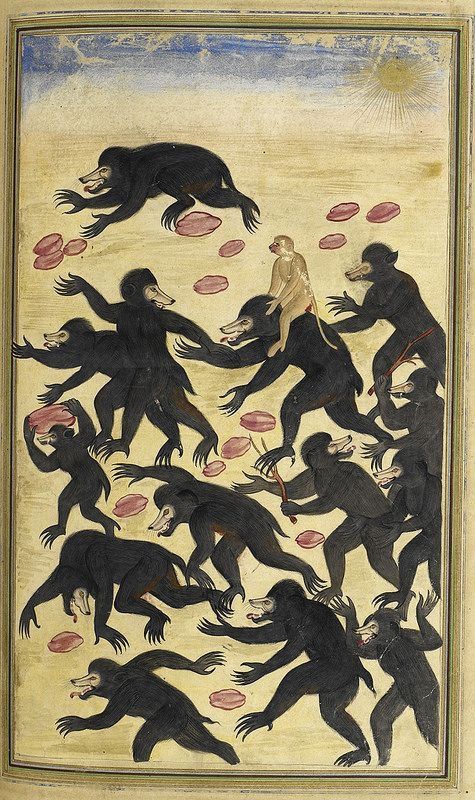
Anvar-i-Suhaili
Indo-Persian miniature,
Gujarat, 1600–1601.
Monkeys outwit bears.
From a manuscript of a collection of fables called “Anvar-i-Suhaili” by Hussei Vaiz Kashifi.
Ms. Or. 6317, fol. 124 v,
London, British Library.
#Anvar-i-Suhaili#Indo-Persian miniature#Gujarat#1600–1601.#Monkeys trick bears.#From a manuscript of a collection of fables called “Anvar-i-Suhaili” by Hussei Vaiz Kashifi.#British Library.#illustration#books#persian miniature#indian minature#mughal miniature
638 notes
·
View notes
Photo

Witness (2023)
by Shahzia Sikander
#2020s art#contemporary art#WoC Art#Pakistani American Artist#indo persian#Miniatures#Public Art#sculpture#feminist art#Great Goddess#divine feminine
31 notes
·
View notes
Text



Last week, the Madison Square Park Conservancy unveiled its latest commission, Shahzia Sikander’s three-part installation Havah… to breathe, air, life.
The Pakistani-American artist, best known for her painting practice that encapsulates the essence of Indo-Persian miniature works through a feminist lens, translated her specific skillsets across material and scale to also introduce the first female subject upon the ten plinths of the Manhattan Appellate Courthouse’s rooftop (there are other female figures elsewhere on the building), across the street from the park.
Rhea Nayyar spends an afternoon in the park with the artist’s golden monuments in her latest article.
44 notes
·
View notes
Text
Photo Booth: A Double View of the World From Inside Mosques! — In Marwan Bassiouni’s “New Western Views,” the Windows of Muslim Houses of Worship Provide an Unfamiliar Framing For Ordinary Sights.
— By M. Z. Adnan | February 27, 2023
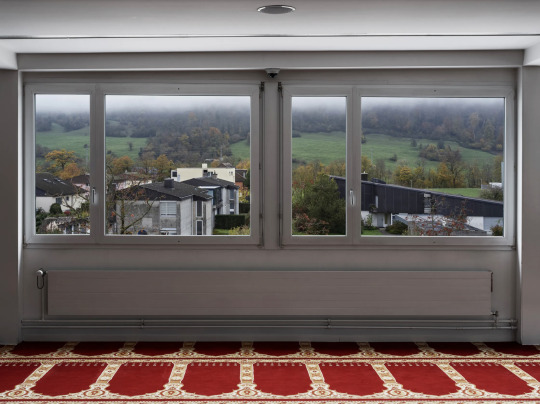
Photographs by Marwan Bassiouni
Marwan Bassiouni’s Photographs in “New Western Views” capture two places at once. Each picture in the series was taken inside a mosque, with the camera pointing toward the windows to reveal the buildings or landscapes beyond. But the pictures give equal weight to the interiors of the mosques themselves, which might be colorful or muted, ornate or spare. Bassiouni began the series in the Netherlands, in 2018, touring the country to visit some seventy mosques while attending art school in the Hague. (A book of those images, “New Dutch Views,” was published in 2019.) Two years ago, he expanded his travels to the United Kingdom and Switzerland. Bassiouni told me recently that he sees the project as an act of portraiture. “I’m photographing spaces that, in a way, have a soul,” he said.
Bassiouni was born in Switzerland, in 1985, to an Egyptian father and an American mother. The nearest mosque was about thirty minutes away, in Geneva—he visited twice a year during Eid and for the occasional Friday prayers. He was not a practicing Muslim until the age of twenty-four, around the time that his interest in photography began. He was working in a restaurant at a ski resort, in the Swiss Alps, and living on its premises. Left alone each evening at the top of the mountain after the other employees left, he began photographing the view with his three-megapixel phone camera. Later, he assisted a commercial photographer on fashion shoots, and then worked as a documentary filmmaker for a human-rights organization focussed on the Middle East, a gig that coincided with the Arab Spring. In making photographs that simultaneously depict both the inside of mosques and their outside environments, he was interested in engaging with popular perceptions of Islam. In the easily suggestible Western imagination, the mosque has often been cast as a site of sinister machinations. Bassiouni’s images offer an alternative gaze from within, with the windows of the prayer rooms providing an unfamiliar framing for ordinary sights: a row of suburban houses; the parking lot of a supermarket, flanked by a red bus in London; looming apartment towers; a sports pitch; a highway; a church.
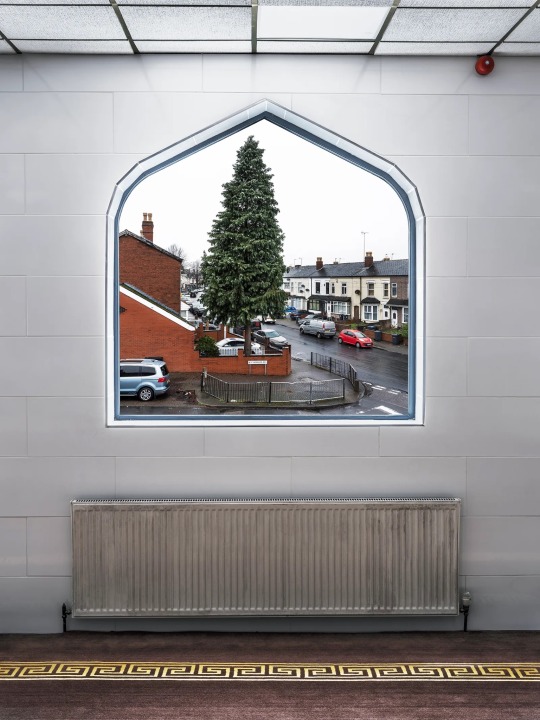


Bassiouni’s approach is informed by the aesthetic values of Islamic art, such as the importance ascribed to geometry, and the notion of euphony with regard to the poetics of the Quran. Every photograph is made with natural lighting and with two exposures, one for the inside and one for the outside space. The images are then combined digitally to produce a scene that corresponds as closely as possible to what appears in reality. “From the Islamic perspective, you’re trying to respect the way things are created,” he said. “So you wouldn’t want to change things, and you wouldn’t be able to do it better. There’s a natural balance and harmony.” Some of the images bring to mind the precision of Indo-Persian miniature paintings, in which elaborate scenes are encased within intricate borders.





Elsewhere, the interior spaces are palimpsests, bearing the quiet traces of previous tenants. In the United Kingdom, Bassiouni has photographed mosques that were formerly cinemas, churches, pubs, night clubs, gentlemen’s clubs, working men’s clubs—their floors now replaced with plush carpets in sapphire or crimson, walls adorned with minarets and Quranic verses. Clues of these past lives are mostly long buried, but occasionally one can identify an old radiator or wood panelling. A wall painted in lime green evokes the possibility of psychedelic forebears.
To view the photographs is to be engulfed in these mysteries. For exhibitions the images are presented at large scale to approximate the experience of being inside the spaces peering out, allowing viewers to imagine that they, too, are standing among the congregants in the room. Ultimately, Bassiouni hopes that audiences will forget that they are looking at a photo. Perhaps they might also forget that there is a separation between the two elements of each photograph, and see that the mosque is as much a part of the landscape as the church or grocery store it looks out on, enmeshed in the mélange of the architecture beyond and the lives that are led there. Bassiouni recalled a recent visit to a mosque in the Swiss canton of Valais at sunset, during the Maghrib prayer. The space was housed in a multipurpose industrial building, whose other rooms were rented out to various businesses. As the prayer concluded, the sound of upbeat music could be distantly heard. In another room, an aerobics class was beginning.

3 notes
·
View notes
Text
Delhi Delights: Experience The Fusion Of Flavors And Cultures

Delhi is a historically significant region that has witnessed various empires' rise and fall, each contributing to its cultural splendor. The city boasts a captivating blend of ancient and modern elements, showcasing its chaotic yet charming asymmetry. On one side, Delhi Tourism Packages retains its ancient allure with architectural marvels, labyrinthine lanes, timeless markets, and vibrant traditional communities, providing a glimpse into its rich heritage. This Old Delhi still holds its traditional values, whereas New Delhi is flourishing with modernization. This diversity in culture makes Delhi a prominent tourist attraction. So we can say Delhi is the heart of India and is a city that embodies the essence of the nation's diverse heritage and culture. Its rich history, vibrant traditions, and bustling modernity converge to create a melting pot of flavors and cultures that is truly unique. For food enthusiasts and adventure seekers alike, Delhi offers a captivating journey through many gastronomic delights and cultural experiences. In this blog, we will delve into the fascinating world of Delhi's culinary and cultural fusion, promising you an unforgettable experience that will leave you craving more.
The Foodie Wonderland:

Delhi's cuisine is a delightful amalgamation of flavors from various Indian regions, including Punjab, Haryana, Maharashtra, and Uttar Pradesh, alongside international and Mughal influences. The city's street food is a significant highlight, offering iconic dishes such as kebabs, chole bhature, jalebis, samosas, and the famous biryani served in earthen pots. Delhi's streets are also adorned with refreshing drinks like flavored lassi, jaljeera, and wood apple sherbet. To experience the diverse array of Delhi's dishes, one can opt for a Delhi thali, a popular dish comprising a variety of small servings of different delicacies. The famous street food of Delhi is a testament to the city's love affair with food.
Old World Charm And Traditional Fare:

Step back in time as you explore the charming alleys of Old Delhi. The streets are adorned with age-old eateries serving traditional delicacies for generations. Savor the taste of authentic Mughlai cuisine at Karim's or delight in the mouth-watering parathas at Paranthe Wali Gali. These age-old establishments continue to preserve the essence of Delhi's culinary heritage.
Arts And Crafts

Delhi's architectural diversity showcases Indo-Persian influences in ancient structures like Jama Masjid, while temples like Chhatarpur and Birla blend Southern and Northern Indian architectural styles. The city's art and crafts, influenced by various regions and neighboring invaders, include iconic jewelry-making techniques like Meenakari and Kundan. Delhi's history dates back to 50 BC, giving rise to diverse crafts like ivory carving and kite making. Mughal rule contributed to art forms such as textile embroidery and miniature paintings. Potteries, enameling works, and zari embroidery are also significant traditional crafts of Delhi. Artworks can be found in markets and galleries, reflecting the city's rich heritage.
Dance and Music

Enjoy traditional dance forms like Kathak, folk dance, Bhangra, and Bharatanatyam in Delhi during major local festivals. Catch shows at Kamani, FICCI, Sri Ram Center, LTG, Siri Fort, and Triveni Kala Sangam. Visit top clubs or hotels like Le Meridien, Park Hotel, Taj Palace, Hyatt Regency, and Maurya Sheraton for dance performances.
Shopping Extravaganza:

Every visit to Delhi is complete with indulging in some retail therapy. Discover the bustling markets of Chandni Chowk and Sarojini Nagar, where you can find everything from traditional textiles to trendy fashion at bargain prices. Take home some delightful souvenirs to cherish the memories of your Delhi Tour Packages.
Fairs And Festivals

Delhi's diverse communities have enriched its culture with a plethora of festivals. Introduced by different regions, these celebrations have now become integral to the city's identity. Notable festivals in Delhi include Independence Day and Republic Day, Phoolkwalon-ki-Sair in September or October, the Qutub Festival in November or December, the International Mango Festival in July, Diwali in October or November, Holi in March, and Navaratri/Dussehra in September or October. Each festival adds its unique charm to Delhi's vibrant cultural tapestry.
Tourist Attractions

Delhi Tour Package attractions encompass a blend of historical marvels and modern landmarks. Such as:
Chattarpur Temple
Qutub Minar
Lotus Temple
India Gate
Jama Masjid
Red Fort
Humayun's Tomb
Chandini Chowk
Hauz Khas Village
Rashtrapati Bhawan
Akshardham Temple
Jantar Mantar
Rajghat
ConclusionDelhi's fusion of flavors and cultures offers a captivating journey for travelers. From its irresistible street food to the grandeur of historical monuments, the city truly has something for everyone. If you plan to visit Delhi, Indiator is your one-stop solution for affordable Delhi Tourism Packages. With flights, hotels, private tour guides, and private cars, you can Book Online Delhi Tour Packages from Indiator and so many travel platforms. Indiator ensures a seamless and unforgettable experience of Delhi's delights.
0 notes
Text
Touring Delhi with a Cab Service!
Table of Content
Introduction
Akshardham Temple
Red Fort
India Gate
HauzKhas
Connaught Palace
Introduction
If seeing new and exciting places are something you enjoy doing, then a trip to Delhi should be at the top of your list. India's capital, Delhi, is among the country's most gorgeous cities and also one of its busiest and most well-known commercial hubs. There are now two separate areas of Delhi, the regal Old Delhi and the seductive New Delhi. You can book cab service in Delhiwith Chiku Cab in both these Delhi. The city's location along the picturesque Yamuna River is a major draw for visitors. While in town, tourists can choose from various activities and attractions. The metropolis is studded with spectacular historical ruins, luscious Mughal gardens, busy streets, and towering complexes. This city has excellent access to highways, trains, and airways. Getting about Delhi and the National Capital Region (NCR) on vacation is much simpler, thanks to the taxi service in Delhi with Chiku Cab. Several of Delhi's top tourism destinations are:
Akshardham Temple
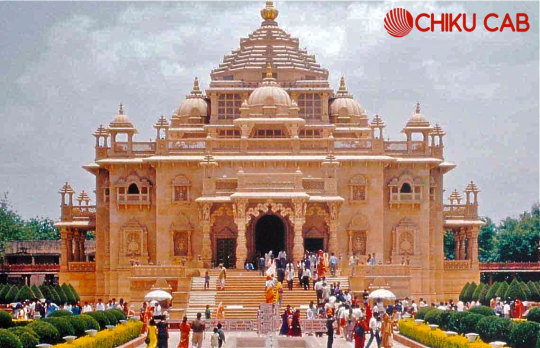
The temple is an architectural marvel made of intricately carved sandstone and marble; the Guinness Book of World Records recognizes it as the largest complete Hindu Temple in the world. As if that weren't enough, every night at twilight, the temple puts on a musical fountain and light show commemorating the life and teachings of Lord Swaminarayan.
Red Fort

The Red Fort, erected by the Mughals in 1639, receives its name from the size of its red sandstone walls. The 254-acre fort, which is octagonal in design, is located in Delhi and may be explored via cab service in Delhi with Chiku Cab. A blend of Mughal, Persian, Hindu, and Timurid traditions went into the planning and construction of the fort. The Red Fort, which had a considerable impact on the succeeding projects built in and around Delhi, contains a museum featuring artefacts from the Mughal Empire, including daggers, drapes, miniature paintings, and carpets. The Peacock throne, step well, royal bath, Moti Masjid, and Hira Mahal are a few of this architectural creativity's prominent characteristics.
India Gate

The Indian Gate is a memorial to the 70,000 Indian troops who died defending our country against an invading army in World War 1. Edwin Lutyens constructed it, and it has the perpetual Amar JawanJyoti, also known as the Flame of the Immortal Soldier, which was later added to honour Indian soldiers who perished in the Indo-Pak conflict. This wonderful work of art is also one of India's biggest military memorials. The building, set on a Bharatpur stone foundation and surrounded by green grass, is a popular spot for outdoor gatherings all year round. With green mountains surrounding it, the monument is magnificent when lit up. You can always plan a short trip to India Gate with a taxi service in Delhi airport by Chiku Cab.
Hauz Khas
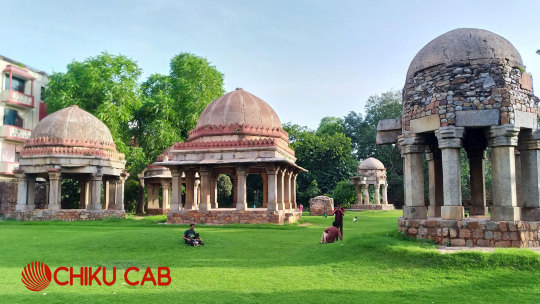
If you love to party, you should visit HauzKhas, known for its posh clubs, distinctive cafes, and fine eating outlets. This posh enclave in South Delhi, originally known as Hauz-e-Alai, has historical value due to the existence of Mughal architectural ruins. The region is well renowned for the HauzKhas Complex, a 13th-century tower that yet emanates vintage beauty despite being situated on a modern roadway. Deer Park's beautiful surrounds, splurging at brand label stores and perusing the magnificent artwork at numerous art galleries are all highly recommended, in addition to having a blast at Delhi's Urban Village.
Connaught Palace
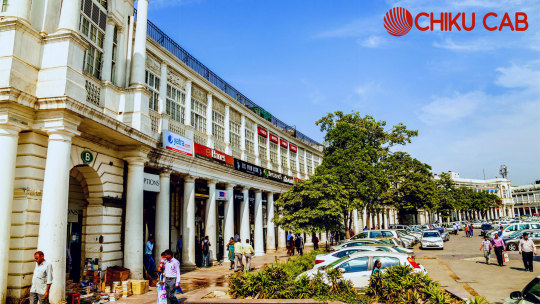
Connaught Palace, commonly referred to as CP and located in the middle of the National Capital, is recognised as one of the wealthiest commercial markets in the entire world. It is also recognised for holding national and international name stores, luxury hotels, and flea markets.
To travel safely, book a cab service in Delhi with Chiku Cab.
#cab service in Delhi#taxi service in Delhi#car hire in Delhi#car rental in Delhi#outstation cab in Delhi
0 notes
Text
Exhibition of Paintings from Iran at AAFT School of Animation

Noida: “Human Being it seems are at their best when immersed deeply in something challenging. Creativity does not wait for that moment it fashions its own perfect moments out of ordinary ones. Persian art or Iranian art has one of the richest art heritages in world history and has been strong in many media including architecture, painting, weaving, pottery, calligraphy, metalworking and sculpture,” said Dr. Sandeep Marwah President of AAFT School of Animation at the inauguration of exhibition of miniature paintings from Iran at AAFT campus.
“Characteristics of Persian miniature painting include the use of sharply defined areas of bright, pure color and the exacting depiction of detail in both background and foreground; these distinguish Persian painting from European painting,” added Dr. Mohd. Ali Rabbani, Cultural Counselor Iran Culture House, Embassy of Iran in the capacity of Chief Guest of the show.
The exhibition was created by well-known artists from Iran Goordraz Azad Panahi and Hamzah Ali Quadari also visiting professors in Iran Universities. The guest also release the books prepared by the students of AAFT School of Animation.
Forty different paintings depicting the art and culture of Iran were displayed for the students and faculty to learn and enjoy. A workshop how to paint miniatures was conducted by Goodraz Azad Panahi & Hamzah Ali Quadari.
Later Sandeep Marwah honoured the guest with the life membership of World Peace Development and Research Foundation. Director Ashish Garg presented vote of thanks and conducted the program. The event was supported by International Chamber of Media and Entertainment Industry & Indo Iran Film and Cultural Forum.
#Exhibition of Paintings Inaugurated at AAFT School of Animation#Dr. Sandeep Marwah President of AAFT School of Animation
0 notes
Text
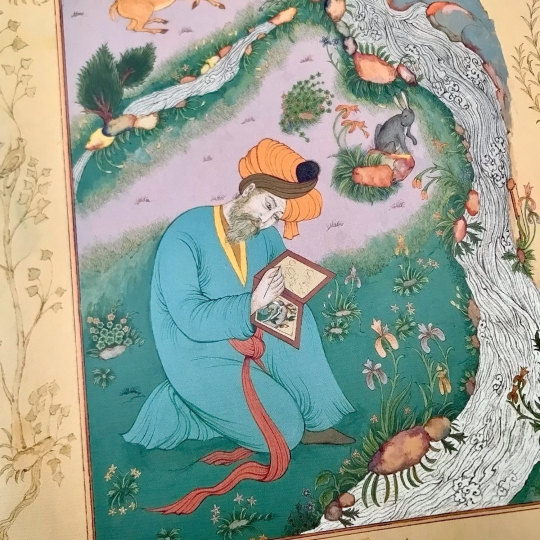
#persian miniature#persian art#miniature persane#indopersianminiature#miniature indo persane#ETSY#etsyseller#ETSY France#laureen Topalian#derviche#dervish
0 notes
Photo

Shahzia Sikander - Candied
Trained in the rigorous art of Indo-Persian miniature painting, Shahzia Sikander explores history, politics, religion, and identity in her own work. She simultaneously adheres to and subverts the strictures of this centuries-old artistic tradition, playing with its iconography and freely sampling imagery from a range of sources to challenge such polarities as Hindu and Muslim and East and West. In Candied, she places a tangle of bodies—male, female, animal, and possibly divine—in the center of a page stained with delicate washes of ink. Cascading disembodied silhouettes of the stylized hair of the Gopi women, worshippers of the Hindu god Krishna, overlay these figures. For Sikander, this is a playful and intentionally ambiguous image, with which she has said that she hopes to create “a gap, or a distance, or a break” in political, religious, and other fixed ideologies, opening up possibilities for uncertainty and the discovery of different perspectives.
1 note
·
View note
Text
Connecting Chitra’s work to Riya Chandiramani
An artist that reminds me of Chitra’s work is Riya Chandiramani, she is is an Indian artist based in Hong Kong. In her work she also explores gender roles and expectations in Indian society. Specifically in one of her recent series called Cereal Box, she destigmatizes women’s bodies, criticizes consumerism, and break stereotypes on gender roles through the incorporating and imitation of powerful Indian goddesses into coral boxes. The paintings draw inspiration from Indo-Persian miniature paintings as well as Chinese Mao-era propaganda posters and commercial branding of consumer products.
It’s inspiring to see brown women use their privilege and voice in Western settings to promote ideas of female empowerment and object to the standards that are set in their home countries. I constantly push to spread these concepts in my work as well so that it raises awareness and globalizes understandings.
November 8th, 2020
1 note
·
View note
Photo

Memory Vignettes and Poem-Paintings Series Artist Reception: 6th March 2020 Exhibit Dates: March 1, 2020 - April 30, 2020 The Oakland Asian Cultural Center presents works of Salma Arastu from her memory vingettes series: “As a woman, Hindu, Muslim, artist, and mother, I work to create harmony by expressing the universality of humanity through paintings, sculpture, and calligraphy. Inspired by the imagery, sculpture, and writings of my Indian heritage and Islamic spirituality, I use my artistic voice to break down the barriers that divide in order to foster peace and understanding.” – Salma Arastu These series draw inspiration from Salma’s childhood memories from Rajasthan, India and stories of youth spent in Hyderabad, India, Iran and Kuwait. These works echo Indo-Persian miniature paintings and Folk art while pushing the boundaries of form, composition, and narrative to emphasize the messages visually. #eastbayartists #miniatures #miniaturepaintings #gold #penandink #contemporaryminiature #paintingon board #goldglaze #salmaarastustudio (at San Francisco, California) https://www.instagram.com/p/B9UbMDeBplO/?igshid=1o8xuyop4wa7p
#eastbayartists#miniatures#miniaturepaintings#gold#penandink#contemporaryminiature#paintingon#goldglaze#salmaarastustudio
1 note
·
View note
Text
Shahzia Sikander, Pakistani-American visual artist, Born 1969 (age 50 years), Lahore
Shahzia Sikander, Pakistani-American visual artist, Born 1969 (age 50 years), Lahore
A Pakistani artist and painter specializes in Indian and Persian miniature painting fused the traditional style that is highly schematic and methodical, merges the contemporary issues of Indo-Persian identity with her artistries. Shahzia Sikander’s miniature paintings reinvent the genre, blending the eastern methodology and centring meticulousness with a western inclination toward creative and…
View On WordPress
1 note
·
View note
Text
Natural Colours & Pigments by Fatima Zahra Hassan
Natural Colours & Pigments by Fatima Zahra Hassan
In the traditional Indo-Persian style of miniature painting, the role and use of colour is of extreme significance, both in terms of visual representation and symbolic meaning. However, our concern here is to concentrate on the quality and nature of these pigments and how they were prepared and applied in this art form. The research work of porter and Minorsky[1] in this field, clearly indicates…

View On WordPress
0 notes
Link
Miniatures from several souths | Art & Culture | thenews.com.pk Hasnat Mehmood. Cut Along the White Line. 2004 How would the painters whose work is part of the South Asian Art Institute’s exhibition, Old Traditions, New Narratives, interact if they were somehow gathered at one place? Would they be able to relate to one another, or recognise a common lineage? How would, for instance, the painter of Mughal miniature Sufi Seated with Ladies on a Terrace communicate with Mohammad Zeeshan, the maker of Dying Miniature Series; or Abdur Rahman Chughtai (of Standing Lady) converse with Saira Waseem, who created Identity? Perhaps all twenty-five artists from this exhibition may act like people working on the Tower of Babel; each speaking in a different tongue, while the memory of a shared language is still fresh in their mouths and minds. We believe today that painters of Mughal, Pahari, Rajput, Decani, Company School, AR Chughtai, Bashir Ahmed and his numerous students (Shahzia Sikander, Imran Qureshi, Nusra Latif Qureshi, Aisha Khalid, Talha Rathore, Saira Wasim, Mohammad Zeeshan, Hasnat Mehmood, Waseem Ahmed, Khadim Ali, Wardha Shabbir and others) belong to a tradition. We call it the Indian miniature painting. Its presence – to some extent – can also be traced among artists not trained in the discipline of miniature art such as Rashid Rana, Faiza Butt, Ali Kazim, Imran Channa, Imran Mudassar and Farhat Ali. However, the idea of belonging to a tradition is merely a longing for shelving individual artists into a category, movement or genre. This is an attitude ingrained by European art history based upon splitting art practices into periods, schools and movements. Ijazul Hassan, noticing this approach, once remarked that in the late nineteenth century Paris, there were realists, symbolists, impressionists, and post-impressionists, meeting and greeting one another as painters and not worried too much with labels tagged to their work by art historians and critics. In that sense, the exhibition organised by the South Asian Art Institute, Chicago, (September 8, 2020 – February 28, 2021) reminds us of a latent diversity in our tradition of art making. It provides an opportunity to view individual choices and formal preferences in works made by artists, who are lugged together as ‘miniature painters’. Probably the difference among a painter of Mughal court and Decani, or a Basohli and Kangra artist would be as pronounced and detectable as between Imran Qureshi and Amjad Ali Talpur, between Nusra Latif Qureshi and Khadim Ali, between Hasnat Mehmood and Waseem Ahmed. Actually, these artists are not following a single tradition. Each of them has carved something new by combining elements, concerns and techniques of indigenous, European, modern and contemporary art. In the exhibition consisting of 100 works, one of the oldest paintings is: Executioner Presents the Head of John the Baptist to Salome, on a Platter, While Herod Sits on a Dias. It was an appropriation of European imagery. Another work deals with the story of Prophet Joseph and Zuleika (portrayed with her female friends holding apples and knives in hands), all in the attires of Mughal period. For these painters of the past, like any artist, there were no boundaries. Prior to nation-states, there were no passports or visas. Traders, missionaries, professionals or outcasts moved from one region to another, without today’s restrictions. Likewise, the art was not bound and did not bow down to a national flavour/obligation. As painters from Mughal court domesticated Western/Christian paintings, Rembrandt copied miniatures from Shah Jahan’s period. Cultures were in conversation, and so were artists. Today too, artists are not limited or restrained by format or convention. In any case, a person living in today’s wealth of gadgets and web of information technology, cannot be detached from the rest of the world, especially the West. Artists are freely appropriating, assimilating and invading other traditions. Diverse in their imagery, concerns, method – so much so that it is hard to classify them as a group; but who knows that 500 years later all their works would be seen as closely connected as we view historic miniatures from different courts and periods as one. Although it seems that the exhibition intends to bridge a link between the past and the present, it seems that the present is also diffused. The display of artworks, both historical and new, by artists from the region and other countries, using conventional vocabulary and contemporary language, executed in different mediums and a range of techniques available now – certifies that tradition does not exist till a new narrative defines it, defies it or destroys it. The history of exploring, excavating and exterminating tradition is visible at various levels in the works of artists from the generation of Shahzia Sikander and Rashid Rana to the most recent ones such as Asif Ahmed and Farhat Ali. One must also recall that old master of modern miniature, Abdur Rahman Chughtai, who was the first to modernise the tradition of Indian miniature painting, and being a Muslim of North India, referred to Persian miniature, as he was associating his art with Indo-Persian cultural expression, by illustrating Urdu poets in his Muraqqa-i-Chughtai (Ghalib) and Amal-i-Chaghtai (Iqbal). Looking at Chughtai now, one can appreciate how modern he was, before the term ‘modern’ gained common currency, here, in a colonized community. His painting, shown in Chicago, confirms that an artist of genius can foresee his followers. More than Bashir Ahmed, or other celebrated names, it was Chughtai, who transformed, and translated miniature painting into the present-day lingo. In the exhibition, one observes the way artists from diverse backgrounds have added to what is now called ‘Neo-Miniature’. From Shahzia Sikander and Imran Qureshi to later generations, they have created digital prints, mixed media, installations, video projections and performances. Their link to miniature painting, or to a place where this art form flourished in the past, is as exciting as looking at miniatures made by Jethro Buck, the “British miniaturist who graduated from the Prince’s School of Traditional Arts in London and studied miniature painting in Jaipur, India”, or of Alexander Gorlizki, a “British artist who graduated from Slade School of Fine Arts, London”. Coming across works by celebrated names of Neo-Miniature, and other contemporary artists from Pakistan, one admits that more than you living in the past, the past lives in you with all its neighbours, friends and foes from different directions and locations. The writer is an art critic based in Lahore https://timespakistan.com/miniatures-from-several-souths-art-culture-thenews-com-pk/8584/
0 notes
Photo




Shahzia Sikander, b. Pakistan, 1969
Portrait of the Artist
US (2016)
Etchings
[Source]
With Indo-Persian miniature painting forming the basis for all of her work—including her own approach to this traditional art form, as well as animation, video, photography, murals, and installation—Shahzia Sikander explores history, politics, and current events, as well as interpersonal themes. She trained under a traditional master, and went on to pioneer alternative approaches to miniature painting. “I found it ripe with potential—to change its status and its narrative and to deconstruct its stereotypes,” she writes. “I recognized…a path to expanding the medium from within, embracing the complexities of craft and rigor in order to open up possibilities for dialogue.” Among the ways she does this is by combining different religious and cultural references in her internationally acclaimed work, which was included in the 2005 Venice Biennale and the 1997 Whitney Biennial.
6 notes
·
View notes
Photo
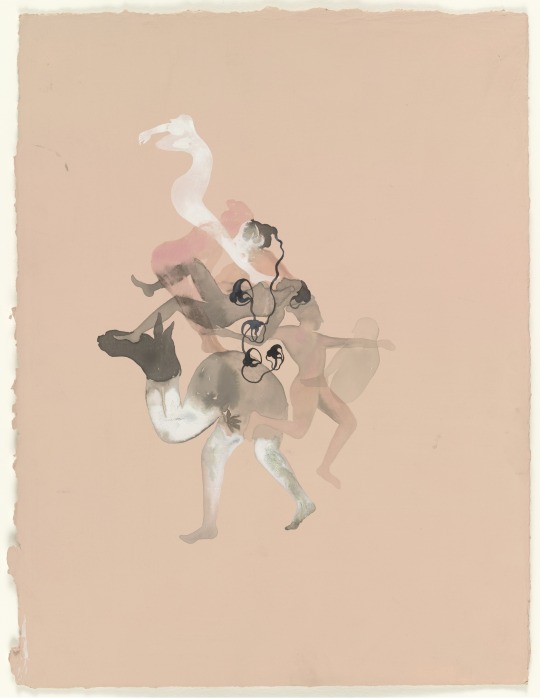
Shahzia Sikander. Candied. 2003. Ink, colored ink, and gouache on twenty pieces of prepared paper, each: 15 x 11" (38.1 x 27.9 cm). The Judith Rothschild Foundation Contemporary Drawings Collection Gift. © 2016 Shahzia Sikander
“Trained in the rigorous art of Indo-Persian miniature painting, Shahzia Sikander explores history, politics, religion, and identity in her own work. She simultaneously adheres to and subverts the strictures of this centuries-old artistic tradition, playing with its iconography and freely sampling imagery from a range of sources to challenge such polarities as Hindu and Muslim and East and West. In Candied, she places a tangle of bodies—male, female, animal, and possibly divine—in the center of a page stained with delicate washes of ink. Cascading disembodied silhouettes of the stylized hair of the Gopi women, worshippers of the Hindu god Krishna, overlay these figures. For Sikander, this is a playful and intentionally ambiguous image, with which she has said that she hopes to create “a gap, or a distance, or a break” in political, religious, and other fixed ideologies, opening up possibilities for uncertainty and the discovery of different perspectives.“ -MoMA
0 notes